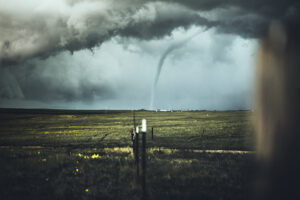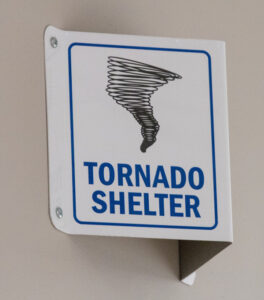A Crisis Management Plan is Crucial to Small Business Disaster Recovery
Updated: April 28, 2023
Disasters come in all shapes and sizes. Homes and businesses are lost to residential and commercial fires. Neighborhoods are destroyed by hurricanes and tornadoes. Entire towns are lost to wildfires. And this year, regions have been buried by snow or flooded by unrelenting winter storms. For reasons like these, having a crisis management and disaster recovery plan for your business is essential.
September is generally recognized as National Preparedness Month by the Department of Homeland Security. That’s traditionally the peak of the Atlantic hurricane season. But with the wild way weather seems to be changing, people and their businesses should be prepared for anything to happen year-round. That’s why having a crisis management and disaster recovery plan for your business is critical.
 Tornado season in the U.S. typically begins in May and runs into the warmer summer months. This year, however, in late March, severe weather caused tornado outbreaks from the upper Midwest to the Gulf states killing more than two dozen people and leaving many homeless. One of the tornados ripped through the small town of Amory, Mississippi leaving it in shambles. It narrowly missed Amory Hardware, one of Shane Wells’ two stores in the region.
Tornado season in the U.S. typically begins in May and runs into the warmer summer months. This year, however, in late March, severe weather caused tornado outbreaks from the upper Midwest to the Gulf states killing more than two dozen people and leaving many homeless. One of the tornados ripped through the small town of Amory, Mississippi leaving it in shambles. It narrowly missed Amory Hardware, one of Shane Wells’ two stores in the region.
“Yes, it just missed us by two blocks. We lost part of our lumberyard and roof, but we are good and have minimal damage compared to others,” wrote Shane, whose store, while recovering from its own damage was open to help the community clean up and rebuild.
John and Cris Henkle know that situation all too well. Their store has pitched in many times over the years to help their communities in times of disaster. Years before they expanded their Henkle’s Ace Hardware business to Joplin, that community was hit hard by a tornado outbreak in May 2011.
During an early season outbreak, Joplin had nearly 8,000 buildings damaged, and close to 4,000 destroyed. The damage included one of Joplin’s two hospitals amounted to $2.8 billion, making it the costliest single tornado in U.S. history at the time. Henkle’s Hardware was one of the stores that helped the town rescue and recover.
“I worked in search and recovery for about a week and a half to find missing people. When that finished, then the work began to clean up,” Cris said. They cleaned and sharpened chainsaws used in the cleanup effort nightly for close to six weeks to help the recovery and rebuilding effort.
Crisis Management
Business owners need to plan for how their employees and customers will react to a similar situation. The plan should include evacuation routes, rallying points, a readily available emergency kit, and a communications strategy.
 Communications are critical in the moments during and immediately following a disaster. In the age when nearly everybody carries a cellphone that also has text and email capabilities, it’s important to have each employee’s contact numbers and addresses. A communications tree and emergency procedures can let employees know who to contact when something goes wrong.
Communications are critical in the moments during and immediately following a disaster. In the age when nearly everybody carries a cellphone that also has text and email capabilities, it’s important to have each employee’s contact numbers and addresses. A communications tree and emergency procedures can let employees know who to contact when something goes wrong.
Emergency numbers should reach beyond police and fire departments to include your business insurance company, electrician, plumber, city or county public works departments, gas and electric companies, local hospitals and health organizations, and even media such as local newspapers or television stations. This information should be stored offsite or in a cloud-based host for easy access.
An emergency kit is vital, too, for employees and customers of your business. It should include battery-powered walkie-talkies to add another layer of communications redundancy, flashlights, first-aid supplies and instructions, and enough water and non-perishable food to hold several people for at least 72 hours.
Disaster Recovery
As part of your disaster preparation, it’s vitally important to identify what it will take to recover and get back to work. Every business is different, but each should assign priorities of high, medium and low to every operation necessary to reopen the doors.
Small businesses today rely on data and the digital platforms that hold it. So, being ready for a disaster with up-to-date records and backup data is critical.
Make at least 3 copies
In 2 different formats
With 1 of those copies stored offsite
Information Technology (IT) recovery involves more than just accessing backup data. Businesses will have to replace hardware – network appliances, servers, desktop and laptop computers, point of sale hardware including displays, monitors, cash drawers, barcode scanners and payment terminals – wireless devices and more.
Comprehensive retail technology companies offer all these products, services and hardware, and their support can supply both backup data and hardware in the event of a disaster.
It’s important to document your business equipment. For retail merchants, inventory records, along with lists and photographs of business machines like computers, point-of-sale terminals, scanners, printers and supplies will speed up insurance claims.
A Business Continuity Plan is another critical part of recovery. It identifies resources needed for recovery – employees, office space, IT, backup data, production or warehouse facilities, and utilities – and the strategies for getting them in a worst-case scenario. The plan should also estimate the costs involved with reopening a store or finding a new location.
Preparing Your Plans
A story posted on HomeImprovementRetailer.com offers some simple and effective tips on how businesses can prepare for natural disasters. As it chronicles, most businesses – 58% – don’t have disaster plans to help them stay open or recover from temporary closure. That can be fatal for small businesses.
The first step in preparation is determining what kinds of disasters could befall your business. Earthquakes, wildfires and floods are prevalent in the Western States. Tornadoes, wildfires and floods cover the Midwest and Southwest. Hurricanes and flooding can take place just about anywhere along the Eastern seaboard. Extreme winter conditions can happen from Portland, Oregon to Portland, Maine. That means it doesn’t make sense to prepare for a deep freeze in Southern California or earthquakes in Iowa. So, focus on what disasters hit close to home. The SBA provides a checklist and tips for specific types of disasters.
 Once that list is complete, it’s time to make your own crisis management and business recovery checklist. Each kind of disaster poses different circumstances and challenges, and each will need its own management and recovery plan. Many coastal communities are susceptible to tsunamis, so coastal evacuation routes should be documented. Tornado and hurricane shelters need to be identified and mapped for both employees and customers in areas where those kinds of storms occur.
Once that list is complete, it’s time to make your own crisis management and business recovery checklist. Each kind of disaster poses different circumstances and challenges, and each will need its own management and recovery plan. Many coastal communities are susceptible to tsunamis, so coastal evacuation routes should be documented. Tornado and hurricane shelters need to be identified and mapped for both employees and customers in areas where those kinds of storms occur.
Regional disaster emergency systems feature warning sirens. Those signals and messages should be noted and understood by employees. Other regions with nuclear power plants have layers of emergency planning zones and evacuation routes. Every possible scenario needs to be covered in a crisis management plan.
The Red Cross Ready Rating provides a free service to help businesses become prepared for emergencies of all kinds.
SBA Assistance
The Small Business Administration (SBA), which recognizes the contributions of entrepreneurs each year with National Small Business Week (April 30-May 6, 2023), supports businesses through a variety of programs including disaster loan assistance.
Not Every Crisis is a Disaster
It doesn’t take a catastrophic wildfire, hurricane, tornado, or flood to create a crisis. Localized problems such as gas leaks, electricity outages, broken water lines, and even lengthy internet service interruptions can disrupt business. Having crisis management and business recovery plans can help you and your business bounce back quicker from a disaster of any magnitude.
Resources
Ready.gov – Ready is a national public service campaign designed to educate and empower Americans to prepare for and respond to emergencies and disasters.
FEMA – The Federal Emergency Management Agency offers businesses emergency response planning for businesses.
U.S. Small Business Administration – The SBA provides disaster loan assistance for businesses, private nonprofits, homeowners and renters.
Red Cross – The American Red Cross offers Ready Rating, a free service that helps organizations become better prepared for an emergency or disaster.
brian bullock
Author


